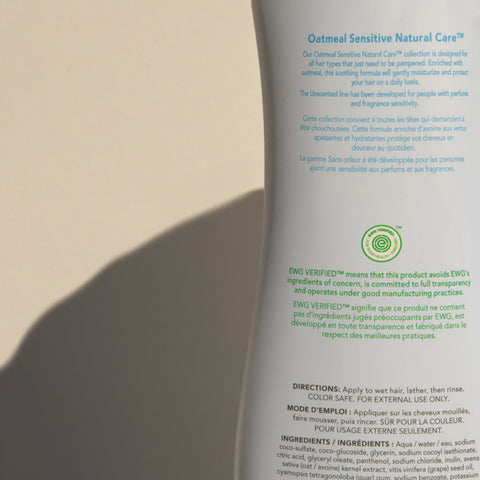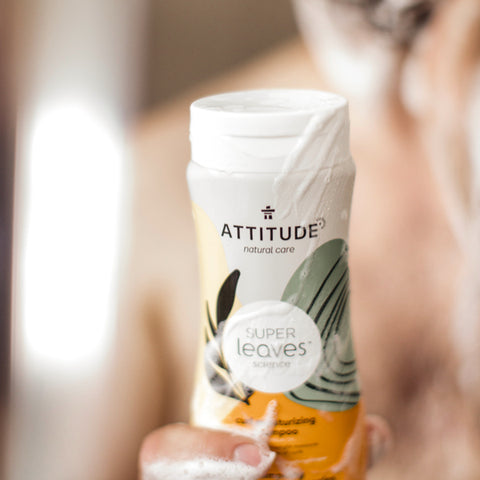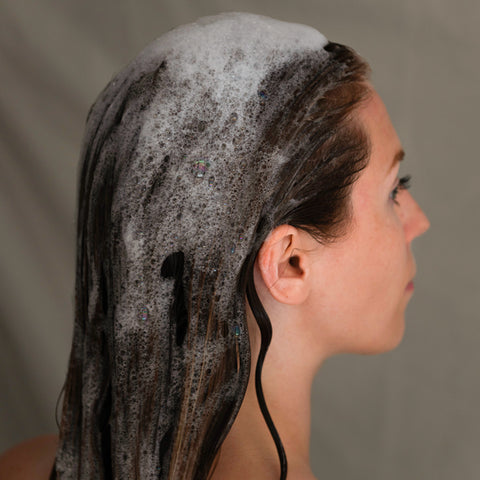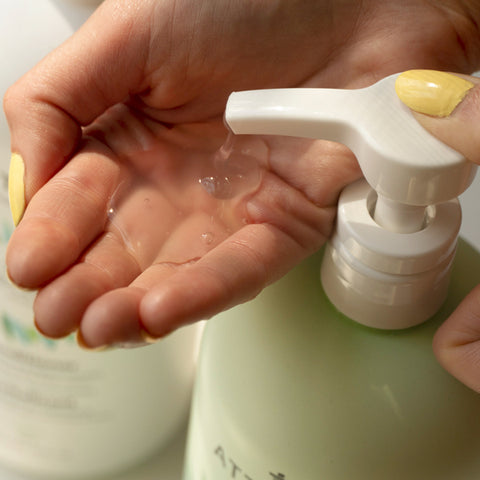10 Ingredient Categories To Avoid In A Shampoo
Nowadays, more people are looking for natural shampoos, softer for their hair, eco-friendly and kind on the environment. All those labels filled with information, it gets confusing! “Sulphate free”, “Silicone free”, “Paraben free” … what information is true and what should you base your choice on? Is it enough to just avoid certain ingredients?
In order to help you to make the right choice, here is a list of 10 ingredients to avoid in your shampoo. We also give you tips and tricks on finding the best natural products!

10 Ingredients Categories To Avoid In A Shampoo*
-
Formaldehyde.
On label: DMDM hydantoin, Diazolidinylurea, Imidazolidinylurea, Quaternium-15: all release formaldehyde which is now a worldwide known carcinogenic contaminant;
-
Ethoxylated surfactants.
On label: Sodium Laureth Sulfate and all the ingredients that end in -eth (eg. Ceteareth, Laureth-4, Laureth-23): they are all contaminated with carcinogenic agents; these ingredients are caused by a reaction with ethylene oxide, a synthetic chemical known to be carcinogenic and contaminated by a manufacturing impurity listed carcinogenic to humans like 1,4-Dioxane. This chemical is listed to be part of the group 2B by the International Agency for Research on Cancer (IARC) because of its cancer-causing properties in humans;
-
Ethoxylated emulsifiers.
On label: PEG, PPG- ..., Polysorbate- (20, 30, 80...): they are all contaminated by carcinogenic substances generated from the reaction caused by ethylene oxide, like the one mentioned above;
-
Ingredients containing amines.
On label: Cocamidopropyl betaine, Triethanolamine and Cocamide DEA/MEA (and all the ingredients that end in ‘DEA’ or ‘MEA’): these ingredients are contaminated by nitrosamines, a chemical known to have cancer-causing risks to humans named in the Proposition 65 list;
-
Artificial dyes.
On label: FD&C, D&C, name of a colour followed by a number or "dye". Artificial dyes may come from petroleum or may contain heavy metals. Some artificial dyes may cause irritation or sensitivity according to EWG, or may be contaminated with recognized carcinogens according to CSPI (Center for Science in the Public Interest).
-
Endocrine disruptors.
On label: Propylparapen, Isopropylparapen, Butylparaben, Isobutylparaben, BHA, BHT, Phthalate, Triclosan: These substances can interfere with the correct functioning of the hormonal system;
-
Isothiazolinones.
On label: Methylisothiazolinone (MIT) and Methylchloroisothiazolinone (CMIT): chemicals known to cause skin allergies and eczema. There have been multiple cases of individuals that developed heightened sensitivity and increase incidents of chemical burns due to these ingredients;
-
Allergens.
On label: Phenoxyethanol, Cinnamal, Citral, Coumarin, Eugenol, Farnesol, Geraniol : Are all allergenic substances listed by the European Scientific Committee for Consumer Safety (CSSC) and the EWG. They pose risks of toxicity (aquatic fauna), irritation and skin allergies. The phenoxyethanol is classified in particular as "moderate danger" for health, in particular for its toxicity to the immune system and for allergies, according to EWG. It is an ingredient of concern;
-
Silicones and polymers.
On label: Dimethicone, Amodimethicone, Acrylates crosspolymer: are synthetics compounds, non-renewable and non-biodegradable sources;
-
Fragrance and perfume.
On label: Fragrance/Parfum. This term, when used alone and not detailed, can group together a multitude of "secret" ingredients in which endocrine disruptors and/or carcinogens and/or synthetics and/or allergens are regularly found. It is impossible to know the composition unless it is listed on the label according to today's recommended practices of the International Nomenclature of Cosmetic Ingredients (INCI). When the ingredients contained in fragrances are listed on the label, it is easier to know what they are, which is the case with ATTITUDE products, whose natural ingredients (plant and flower extracts) are detailed in the list of ingredients. According to the EWG, all of the fragrances we use in our products are free of harmful ingredients.
How To Choose Natural Shampoos?

The government considers that using cleaning and personal care products with carcinogenic agents is not dangerous for our health and tolerate their presence. However, organizations like the EWG or the American foundation Breast Cancer Prevention Partners, who promote the “Campaign for safe cosmetics”, want to expose the danger of these chemicals on us.
Questions are being raised, however it is the consumer’s choice to use natural products or not. Should they constantly search ingredients to avoid in the shampoo and products they use? Who wants to be repetitively exposed throughout their lives to low doses of chemicals contained in our everyday care products? We all react differently to the chemicals in care products. It is up to us to choose our priorities; natural ingredients, without synthetic material, without allergens, without products derived from animals, etc.?
ATTITUDE believes is it essential to find care products with natural ingredients. Here is a list of tips and tricks that will help you easily find the best natural shampoos:
- Choose trust-worthy brands that are certified (by EWG VERIFIED ™, for example); Identify care products and shampoos made with natural ingredients, vegetal or mineral-based; Look up any ingredients that are unknown to you on the Skin Deep Cosmetics Database of the EWG. They list the possible health hazards associated with the chemicals found in the personal care and beauty products;
- Be aware of those so-called Paraben-free, Sulphate-free, Phthalate-free shampoos. Paraben is a preservative often replaced with another dangerous chemical, like Methylisothiazolinone (MIT) and Methylchloroisothiazolinone (CMIT) for instance.

Harmful Substances In Shampoo: What Is The Impact?
The Impact On Health
What is the impact that the use of our shampoos can have on us over time? Science at this times does not have enough data to assess the lifetime impacts of being exposed to these different contaminants. The fact is that our skin is penetrable which means; It can easily absorb a variety of chemicals. Hard to believe, but more than 200 industrial chemicals and pollutants were found in the blood of the umbilical cord of 10 newborns! This study was conducted by the EWG in 2005, by researchers from two major laboratories.
Researchers are just beginning to understand the cumulative effects of prolonged exposure to chemical contaminants in small quantities in our everyday products. It is difficult to determine the impact of these contaminants, their quantity and the interaction between different chemical agents.In response, environmental health studies that analyze our daily exposure to chemical products are increasing. Organizations such as the Organic Consumer Association in the United States, among other things they highlight the presence of contaminants in our cosmetics and are fighting for more transparency in legislation. A positive step in the right direction of change!

The Impact On The Environment
It is important to question what products we use do to our planet. Industries use non-renouvelable resources i.e. repetitive effects on the environment. The chemicals that flow freely through our rivers and lakes affect the sea life. Industrial impurities such as 1.4-dioxane are also very problematic. It is known, for example, that 1.4-dioxane is a substance that cannot be filtered by water purification stations. It accumulates and finds itself in the drinking water.

At ATTITUDE, we believe it is important to be cautious and to rely on a rigorous product development process. That's why all our shampoos are developed from natural ingredients, and all the ingredients to avoid in a shampoo listed in this article are not used in our formulas. Our vision is to question everything and we invite you to do the same! *According to EWG Among our collections, you will find liquid shampoos with eco-refills. We also offer leaves bar plastic-free shampoo bars, to help you reduce your daily plastic consumption.
To find out more about what's in your shampoo, read testimonials on the subject:
What’s In Une Parisienne à Montreal’s Shampoo? What’s in Emily’s Shampoo? (Our Nest in the City) What’s in the Shampoo of the HappyFitness Girls? What's in the Shampoo of Blond Story
Practical Memo: How To Spot Healthy And Safe Ingredients In A Shampoo?
To guide you in finding the safest shampoo for you, here is a list of the safe and healthy ingredients*:
- Sodium Coco-sulfate: a surfactant derived from coconut oil with excellent cleaning power and known to give shampoo its consistency.
- Coco-glucoside: a vegetal foaming agent (surfactant) derived from coconut oil, combined with glucoses (sugars). This ingredient cleanses and smoothes the hair fibers.
- Decyl-glucoside: a surfactant made with glucoses and is derived from cornstarch and coconut oil.
- Lauryl glucoside: a surfactant of plant origin and adapted to formulas for sensitive skin.
- Sodium cocoyl isethionate: a surfactant derived from coconut oil.
- Sodium cocoamphoacetate: a gentle surfactant derived from coconut oil with great foaming power.
- Vegetal glycerin: obtained from rapeseed or coconut oils. It is a moisturizing ingredient for skin and hair.
- Sodium citrate: Sodium salt of citric acid, vegetable origin used as a sequestering, emulsifying or stabilizing agent in a formula.
- Potassium sorbate: the Potassium Salt of Sorbic Acid is a natural fatty acid extracted from the berries of the mountain ash, it is used as an antimicrobial preservative.
- Stearyl citrate: vegetable origin and consisting of Stearyl alcohol and Citric acid is an emollient that softens and moisturizes the skin or hair.
- Glyceryl oleate: vegetable origin, it is an emollient that softens, moisturizes the skin or hair.
- Butyrospermum parkii butter: extracted from the kernels of Shea fruit, it is an emollient that softens and moisturizes the skin or the hair.
- Clays: mineral substances that come from volcanic ashes. In shampoos, we prefer to use red, yellow ochre, yellow illite, pink and blue clays, because these are the ones that naturally increase volume, moisturize, nourish, and detoxify the hair.

Good to know: All of the above ingredients are of plant origin and fully biodegradable.
* The ingredients listed above are examples of worry-free ingredients, but it is important to note that in pure form, they can be irritating. The secret is always in the right dosage and formulation!
Do you want to read other articles wich talk about Cocamidopropyl Betaine? Have a look here :
- What's in Blond Story's shampoo?
- What's in the shampoo of the HappyFitness girls?
- 13 natural ingredients to look for in a shampoo
- Under the microscope | 5 ingredients to avoid in unscented products
- What’s in your cleaning and beauty products?
- The importance to choose natural ingredients in personal care products when pregnant